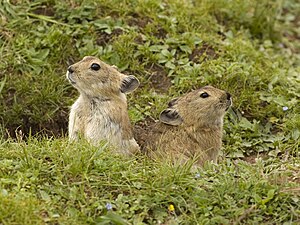Black-lipped pika
| Black-lipped pika | ||||||||||||
|---|---|---|---|---|---|---|---|---|---|---|---|---|

Black-lipped pika ( Ochotona curzoniae ) |
||||||||||||
| Systematics | ||||||||||||
|
||||||||||||
| Scientific name | ||||||||||||
| Ochotona curzoniae | ||||||||||||
| ( Hodgson , 1858) |
The black-lipped pipe hare ( Ochotona curzoniae ) is a species of mammal from the family of the pipe hare (Ochotonidae).
features
Black-lipped pigeon hares have the typical compact physique of the pigeon hares with the small, round ears and the comparatively short limbs. Their dense fur is reddish-brown on the top and gray on the underside, whereby the winter fur, like other whistling hares, is rather greyish. The black-colored lips are the name-giving feature.
distribution and habitat
The black-lipped whistle hares inhabit the highlands of Tibet and adjacent areas in western China , India ( Sikkim ) and Nepal . Their habitat are mountain regions up to 5300 meters above sea level.
Lifestyle and diet
These animals live together in family groups made up of one male, one or two females and five to ten young animals from several generations. They live in complex structures that consist of several tunnels and entrances and serve them both to search for food and to escape from enemies. They are territorial animals that vehemently defend their gait system against other groups or individual animals. Black-lipped pika can be active both day and night. Like all whistle hares, they do not hibernate , but rather store food supplies.
Black-lipped pika eat mainly grass , herbs and plant stems, but also roots.
Reproduction
The reproduction of the black-lipped piphare takes place during the summer months, with the female often having several litters per year. The gestation period is 21 to 24 days, the litter size one to eight (average 4.8). The young grow very quickly and are weaned after three weeks.
literature
- Ronald M. Nowak: Walker's Mammals of the World . Johns Hopkins University Press, 1999. ISBN 0-8018-5789-9
Web links
- Information and photos on Animal Diversity Web
- Ochotona curzoniae in the endangered Red List species the IUCN 2006. Posted by: Lagomorph Specialist Group, 1996. Accessed on 13. May 2007.
